How to Manage Edema After Surgery
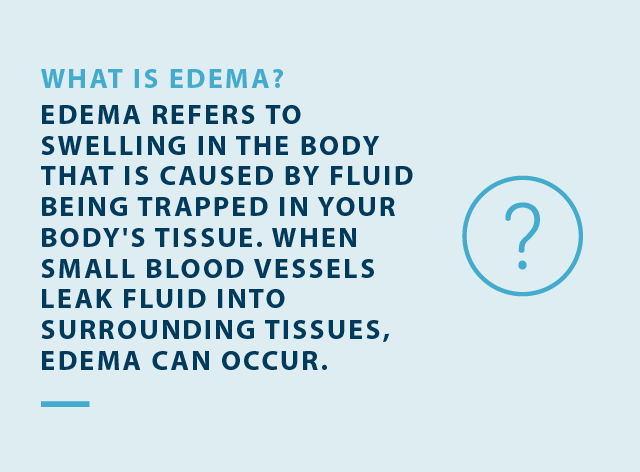

Discomfort can be common after surgery, and that may include swelling, known as edema. Edema after surgery is common, as it’s your body’s natural response to heal itself. There are a few ways to manage post-surgery swelling, such as compression, elevation, and light exercise, that can help reduce the risk of edema after surgery. It’s important to talk to your doctor about the risk of post-surgery edema and what you can do to manage it.
If you want to learn more about swelling after surgery, what causes it, and what you can do to prevent post-surgery swelling, here’s everything you need to know.
What Is Edema?
What Causes Edema?
Is Swelling Normal After Surgery?
What Affects Edema After Surgery?
How Do You Manage Edema After Surgery?
How Long Does Post-Op Edema Last?
What Symptoms Can You Expect After Surgery?
The Bottom Line: Managing Edema After Surgery
What Is Edema
Edema is a medical term for swelling that’s caused by fluid trapped in the soft tissue of the body. While edema most commonly occurs in the arms and legs, it can affect any part of your body. The level of swelling can also vary from person to person, and that swelling may last for a few days, or it may carry on for months. This swelling typically occurs as a result of a leak from small blood vessels, which leads to a buildup of fluid in the soft tissues in your body.
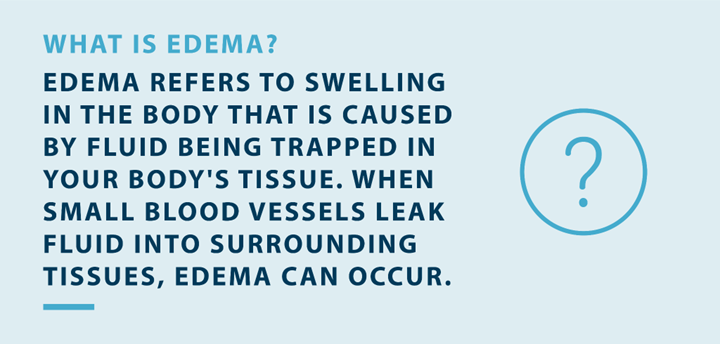
Because swelling after surgery is relatively common, you should talk to your doctor about edema and lymphedema treatment and management post-surgery. Your doctor may recommend light exercise, compression garments, and other preventative care to lower your risk of edema.
While edema may cause discomfort, there are several ways you can manage swelling to reduce pain and irritation. Left untreated, edema can eventually lead to stiffness, difficulty walking, skin ulcers, scarring, and poor circulation. If you’re experiencing swelling after surgery, make sure you talk to your doctor about what you can do to reduce swelling.
What Causes Edema?
Edema is caused by a leak in the small blood vessels that causes fluid to build up in your body’s tissue. However, there are different types of edema that are caused by different types of fluid, including pulmonary edema and lymphedema. Here are some of the potential causes of edema:
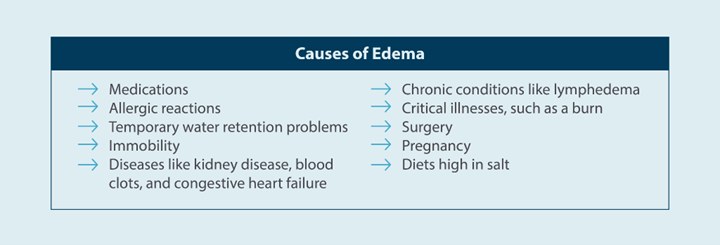
- Medications: Certain medications, such as NSAIDs and corticosteroids, can cause a buildup of fluid that leads to edema.
- Allergic reactions: Swelling caused by an allergic reaction is known as angioedema.
- Water retention problems: If you’re retaining too much water, that can lead to excess fluid and swelling in your body.
- Immobility: Gravity helps fluids move freely throughout your body, so prolonged immobility and a sedentary lifestyle may lead to edema.
- Diseases: Kidney disease, liver disease, and congestive heart failure are some of the diseases that can cause edema.
- Chronic conditions: Certain chronic conditions, such as lymphedema or a blood clot, can disrupt your lymphatic system and cause swelling.
- Critical injuries: Burns, car accidents, and other critical injuries can result in swelling.
- Surgery: Because many patients are largely immobile after surgery, they can experience edema as a side effect. Certain types of surgery, such as lymph node surgery or cancer surgery, can also lead to lymphedema. Before you get surgery, talk to your doctor or surgeon about steps you can take to reduce swelling and stay mobile after your procedure.
- Pregnancy: The extra fluid in the body during pregnancy can lead to edema, especially in the ankles and feet.
- Diet high in salt: Eating too much salt can increase water retention, which can lead to edema as a result of excess fluid.
Is Swelling Normal After Surgery?
One thing to keep in mind is that swelling is completely normal after surgery. Surgery typically involves making incisions that take time to heal, and that healing process involves swelling. When you have what your body perceives as an “injury” after surgery, thousands of cells are sent to the site of the procedure, where they start working to help your body heal faster. When these cells all group up together, it can lead to inflammation and swelling at the site of the procedure.
What Affects Edema After Surgery?
While some swelling is normal after surgery, there are also several factors that affect edema after surgery. Even the type of surgery you have has an effect on the level of post-surgery swelling you experience. Here are some of the main factors that affect edema after surgery:

- Type of procedure: Certain types of procedures, especially those that cause immobility, may be more likely to lead to edema.
- Area of the body: You may be more likely to experience edema if you have surgery in an area where swelling is common, such as your arms or legs.
- Lifestyle: If you’re overweight or live a sedentary lifestyle, you may be at increased risk of developing edema after surgery.
- Genetics: Your genes can also play a role in post-surgery swelling, which means some people are more likely to experience swelling than others.
How Do You Manage Edema After Surgery?
If you’re worried about or are experiencing swelling after a surgical procedure, there are steps you can take to prevent and manage edema after surgery to avoid dealing with discomfort or pain. If you’ve recently had surgery, here are some techniques your doctor may recommend to help reduce swelling and manage edema after surgery.
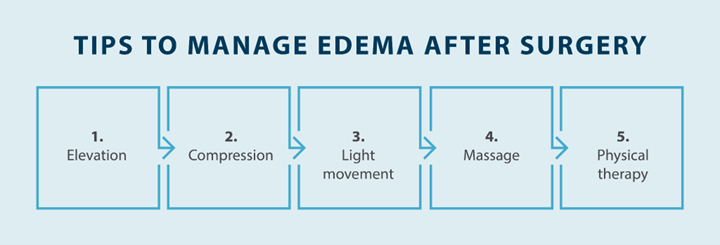
1. Elevation
The fluids in your body are affected by gravity. When you’re sitting down all day, it’s easy for fluid to pool in your lower extremities, which can lead to edema. This is why a lack of mobility is one of the potential causes of edema.
Fortunately, you can manage edema better by keeping the affected parts of your body elevated as much as possible. If you’re experiencing swelling in your legs, ankles, and feet, you can sit or lie down and prop your leg up on a couple of pillows. You can also try lying on your side, lifting one arm up, and holding it there for a few seconds at a time to promote the flow of fluids in your arm.
An important tip is to elevate extremities above the heart when you’re trying to reduce swelling, as this will help fluids flow directly to this area to recirculate. Elevating your leg or arm may be easier when you’re lying down.
2. Compression
If you’re at risk for edema after surgery, you might want to talk to your doctor or surgeon about wearing compression garments. Compression garments and devices use light compression to help encourage the flow of blood and fluids throughout your body.
Before using compression garments or devices, make sure you talk to your doctor about whether they’re safe for you. Improper use of compression garments can lead to further complications in patients with edema, so it’s also important to follow any instructions your doctor or surgeon provides.
As an alternative to traditional compression garments, Tactile Medical offers the Flexitouch Plus System. This pneumatic compression device stimulates the lymphatic system by delivering pressure in 1-3 second increments to direct fluid across the body. Our customized treatment options make it easy to manage swelling, reduce pain, and regain mobility.
3. Light movement
Inactivity can increase your risk of developing edema after surgery, which is one of the reasons post-surgery swelling is so common. Depending on the procedure you had done, it might be difficult to move around and stay active while you’re recovering from surgery.
Even if you can’t walk as a result of your surgery, you can still lower your risk of edema after surgery by incorporating some light activities into your daily routine. There are lymphedema exercises that can help promote lymphatic drainage and improve circulation to relieve swelling. If you’re not sure how to stay active after surgery, your surgeon or physical therapist may be able to offer some advice.
4. Massage
Massage therapy is another way you can prevent swelling that occurs after surgery. Gentle massaging can help promote the flow of fluid through your body, so you can work fluid away from swollen areas and reduce swelling and discomfort. While a massage can be a good way to manage edema, it’s important to talk to your physician first. There are certain techniques you should follow, and your physician may recommend other treatments depending on your condition.
Manual lymphatic drainage therapy is a popular lymphedema treatment option that involves using a sequence of hand motions to redirect fluid to less congested parts of the lymphatic system. While this can be an effective treatment and management method for some, you should talk to a professional before trying lymphatic drainage therapy at home. In most cases, your lymphedema therapist will show you the correct ways to perform manual lymphatic drainage therapy before trying it on your own.
5. Physical therapy
Depending on the type of procedure you had done and how well that procedure went, you may need physical therapy to completely recover from surgery. While physical therapy is primarily focused on restoring strength, mobility, and flexibility in parts of your body that are weaker after an injury or surgery, it can also help relieve the swelling that results from edema.
If you have an upcoming surgery planned, make sure you talk to your surgeon about whether physical therapy is recommended afterward. Physical therapy may not be necessary if you’re having a minor procedure done. Even if you don’t attend physical therapy, it’s important to stay active to prevent edema after surgery.
How Long Does Post-Op Edema Last?
While it’s not uncommon to develop post-surgery swelling, that swelling shouldn’t last for too long. The duration of edema after surgery depends on several factors, including the type of procedure, the affected area of the body, and the age of the patient. In most cases, edema peaks within the first 1-3 days following surgery, so managing swelling is especially important immediately after your procedure. However, edema can persist for several months in some cases, so you should talk to your physician if the swelling continues.
Edema after surgery isn’t generally a concern, but there are a few warning signs to watch out for. If you notice discharge, an increase in swelling, or any other issues near the site of your procedure, you should consult a doctor.
What Symptoms Can You Expect After Surgery?
Swelling is just one of the symptoms you can expect to feel after surgery. Surgery can be hard on your body, which can lead to a wide range of post-op symptoms. In addition to edema, you may feel some of the following post-surgery symptoms:

- Pain
- Nausea
- Restlessness
- Soreness
- Thirst
Similar to how you can take steps to reduce swelling after surgery, there are ways to manage these other symptoms as well. Talking to your physician about managing symptoms is an important step before having a procedure done. Depending on the procedure, your doctor may recommend pain medications, physical therapy, IV therapy, and more after you’ve had surgery. If your doctor gives you advice regarding post-op care, make sure you follow that advice so you make a full recovery from your procedure.
The Bottom Line: Managing Edema After Surgery
Edema after surgery is normal, but it should go away within a few days or a week. You can talk to your physician about managing edema after surgery, including exercises you can do at home. If you notice discharge, increased swelling, or other worsening edema symptoms after surgery, you should see a doctor.
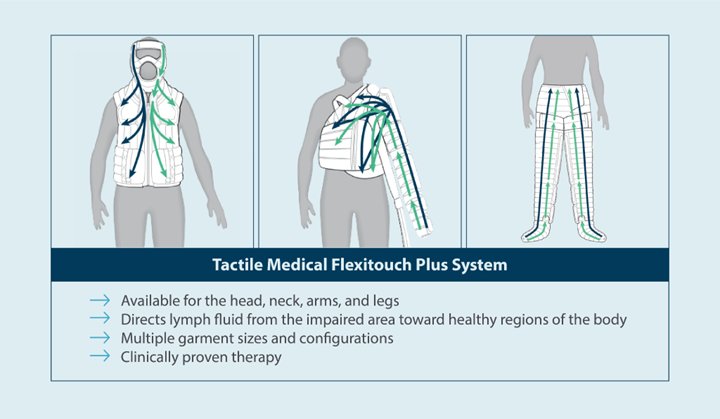
If you need relief from edema, lymphedema, or similar conditions, the Flexitouch Plus System from Tactile Medical is the simple answer. This pneumatic compression device works for your lower body, upper body, and even your head and neck. If you’re having a hard time keeping your lymphedema under control, try the Flexitouch Plus System from Tactile Medical today.
1. Goyal A, Cusick AS, Bhutta BS. Peripheral Edema. [Updated 2022 Jul 10]. In: StatPearls [Internet]. Treasure Island (FL): StatPearls Publishing; 2022 Jan-. Available from: https://www.ncbi.nlm.nih.gov/books/NBK554452/
2. van den Bekerom MP, Struijs PA, Blankevoort L, Welling L, van Dijk CN, Kerkhoffs GM. What is the evidence for rest, ice, compression, and elevation therapy in the treatment of ankle sprains in adults? J Athl Train. 2012 Jul-Aug;47(4):435-43. https://www.ncbi.nlm.nih.gov/pmc/articles/PMC3396304/
3. Lin YH, Chen CY, Cho MH. Effectiveness of leg movement in reducing leg swelling and discomfort in lower extremities. Appl Ergon. 2012 Nov;43(6):1033-7. https://pubmed.ncbi.nlm.nih.gov/22472344/
4. Niamtu III, Joe. Cosmetic Blepharoplasty. Cosmetic Facial Surgery (Second Edition). 2018. https://www.sciencedirect.com/topics/medicine-and-dentistry/postoperative-edema